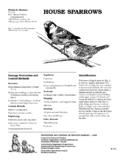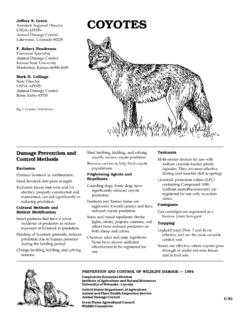Transcription of REPTILES, AMPHIBIANS, ETC. - ICWDM Home Page
1 reptiles , amphibians , R. Woodward and Dennis N. DavidF-7 CrayfishJames F. Fowler, Wendell Lorio, and Greg LutzF-9 Frogs and ToadsPaul E. MolerF-13 SalamandersJames L. ByfordF-15 Snakes, NonpoisonousJames L. ByfordF-21 RattlesnakesWalter E. HowardF-27 TurtlesJames F. Fowler and Jimmy L. AveryF-1 ALLIGATORSA llan R. WoodwardAlligator Research BiologistFlorida Game and Fresh Water FishCommissionGainesville, Florida 32601 Dennis N. DavidAlligator Management Section LeaderFlorida Game and Fresh Water FishCommissionGainesville, Florida 32601 Damage Prevention andControl MethodsExclusionBulkheads along edges of lakes mesh ModificationMinimize emergent ponds and borrow pits whereappropriate and or other harassment canincrease pressure increases warinessand avoidance of are are are hooks and trip-snare traps aremost during the day or night withrifles or MethodsHunt with detachable-head harpoonsor handheld, breakaway with snatch hooks or american alligator (Alligatormississippiensis, Fig.)
2 1) is the most com-mon of two crocodilians native to theUnited States and is one of 22 crocodil-ian species worldwide. The othernative crocodilian is the Americancrocodile (Crocodylus acutus). Caimans(Caiman spp.), imported from Centraland South America, are occasionallyreleased in the United States and cansurvive and reproduce in Florida. TheAmerican alligator is distinguishedfrom the american crocodile andcaiman by its more rounded snout andblack and yellow-white crocodiles and caimans areolive-brown in color and have morepointed snouts. american alligatorsand crocodiles are similar in physicalsize, whereas caimans are 40% 1. american alligator , alligator mississippiensisPREVENTION AND CONTROL OF WILDLIFE DAMAGE 1994 Cooperative Extension DivisionInstitute of Agriculture and Natural ResourcesUniversity of Nebraska - LincolnUnited States Department of AgricultureAnimal and Plant Health Inspection ServiceAnimal Damage ControlGreat Plains Agricultural CouncilWildlife CommitteeF-2 RangeThe american alligator is found inwetlands throughout the coastal plainof the southeastern United alligator populations are foundin Texas, Oklahoma, Arkansas, Louisi-ana, Mississippi, Alabama, Florida,Georgia, South Carolina, and NorthCarolina.
3 The northern range is limitedby low winter temperatures. Alligatorsare rarely found south of the RioGrande drainage. Alligators preferfresh water but also inhabit brackishwater and occasionally venture intosalt water. american crocodiles arescarce and, in the United States, areonly found in the warmer coastalwaters of Florida, south of Tampa andMiami. Caimans rarely survive win-ters north of central Florida and repro-duce only in southernmost can be found in almost anytype of fresh water, but populationdensities are greatest in wetlands withan abundant food supply and adjacentmarsh habitat for nesting. In Texas,Louisiana, and South Carolina, thehighest densities are found in highlyproductive coastal impoundments.
4 InFlorida, highest densities occur innutrient-enriched lakes and and inland marshes maintainthe highest alligator densities in Geor-gia, Alabama, and Mississippi. Alliga-tors commonly inhabit urban wetlands(canals, lagoons, ponds, impound-ments, and streams) throughout HabitsAlligators are exclusively carnivorousand prey upon whatever creatures aremost available. Juvenile alligators (lessthan 4 feet [ m]) eat crustaceans,snails, and small fish; subadults (4 to 6feet [ to m]) eat mostly fish, crus-taceans, small mammals, and birds;and adults (greater than 6 feet [ m])eat fish, mammals, turtles, birds, andother alligators. Diets are range-depen-dent; in Louisiana coastal marshes,adult alligators feed primarily onnutria (Myocastor coypus), whereas inFlorida and northern Louisiana, roughfish and turtles comprise most of thediet.
5 Recent studies in Florida andLouisiana indicate that cannibalism iscommon among alligators. Alligatorsreadily take domestic dogs and cats. Inrural areas, larger alligators takecalves, foals, goats, hogs, domesticwaterfowl, and occasionally, full-grown cattle and Biology,Reproduction, andBehaviorAlligators are ectothermic they relyon external sources of heat to maintainbody temperature. They are mostactive at warmer temperatures andprefer 82o to 92o F (28o to 33o C). Theystop feeding when ambient tempera-ture drops below 70o F (21o C) andbecome dormant below 55o F (13o C).Alligators are among the largest ani-mals in North America. Males canattain a size of more than 14 feet ( ) and 1,000 pounds (473 kg).
6 Femalescan exceed 10 feet ( m) and 250pounds (116 kg). Alligators of bothsexes become sexually mature whenthey attain a length of 6 to 7 feet ( m), but their full reproductivecapacity is not realized until femalesand males are at least 7 feet ( m)and 8 feet ( m) long, begin courtship in Aprilthroughout most of their range andbreed in late May and early lay a single clutch of 30 to 50eggs in a mound of vegetation fromearly June to mid-July. Nests averageabout 2 feet ( m) in height and 5 feet( m) in diameter. Nests are con-structed of the predominant surround-ing vegetation, which is commonlycordgrass (Spartina spp.), sawgrass(Cladium jamaicense), cattail (Typhaspp.), giant reed (Phragmytes spp.)
7 ,other marsh grasses, peat, pineneedles, and/or soil. Females tendtheir nests and sometimes defendthem against intruders, includinghumans. Eggs normally take 65 daysto complete incubation. In late Augustto early September, 9 to 10-inch (23 to25-cm) hatchlings are liberated fromthe nest by the female. She may defendher hatchlings against intruders andstay with them for up to 1 year, butgradually loses her affinity for them asthe next breeding season rates of alligators are variableand dependent on diet, temperature,and sex. Alligators take 7 to 10 years toreach 6 feet ( m) in Louisiana, 9 to14 years in Florida, and up to 16 yearsin North Carolina. When maintainedon farms under ideal temperature andnutrition, alligators can reach a lengthof 6 feet ( m) in 3 are not normally aggressivetoward humans, but aberrant behavioroccasionally occurs.
8 Alligators can andwill attack humans and cause seriousinjury or death. Most attacks are char-acterized by a single bite and releasewith resulting puncture bites are usually made bysmaller alligators (less than 8 feet [ ]) and result in an immediate release,possibly because they were unsure oftheir intended prey. One-third of theattacks, however, involve repeatedbites, major injury, and sometimesdeath. Serious and repeated attacks arenormally made by alligators greaterthan 8 feet in length and are mostlikely the result of chase and feedingbehavior. Unprovoked attacks by alli-gators smaller than 5 feet ( m) inlength are to popular belief, few attackscan be attributed to wounded or terri-torial alligators or females defendingtheir nests or young.
9 Necropsies of alli-gators that have attacked humans haveshown that most are healthy and well-nourished. It is unlikely that alligatorattacks are related to territorialdefense. When defending a territory,alligators display, vocalize, and nor-mally approach on the surface of thewater where they can be more intimi-dating. In most serious alligatorattacks, victims were unaware of thealligator prior to the attack. Femalealligators frequently defend their nestand young, but there have been noconfirmed reports of humans beingbitten by protective females. Broodingfemales typically try to intimidateintruders by displaying and hissingbefore quickly become conditionedto humans, especially when food is in-volved.
10 Feeding-habituated alligatorslose their fear of humans and can bedangerous to unsuspecting humans,especially children. Many aggressiveor fearless alligators have to be re-moved each year following feeding byhumans. Ponds and waterways at golfcourses and high-density housing cre-ate a similar problem when alligatorsbecome accustomed to living and DamageIdentificationDamage by alligators is usually limitedto injuries or death to humans ordomestic animals. Most alligator bitesoccur in Florida, which has document-ed approximately 140 unprovokedattacks from 1972 to 1991, or about 7per year. Since 1972, 5 deaths havebeen positively attributed to , nonfatal attacks have alsobeen documented in South Carolina(8), Louisiana (2), Texas (1), Georgia(1), and Alabama (1).






